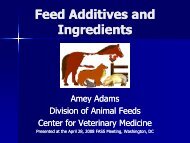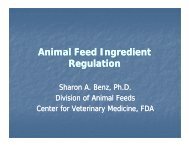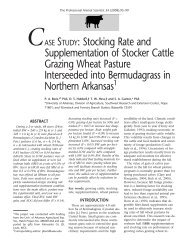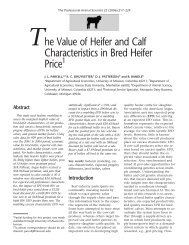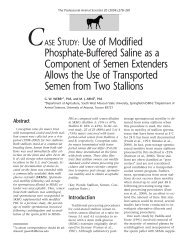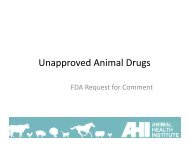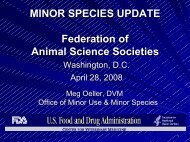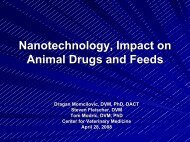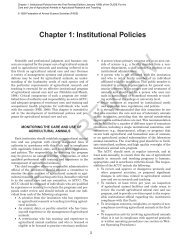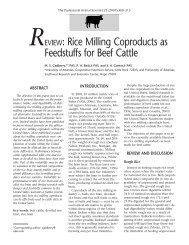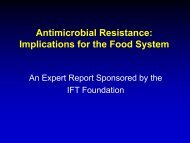outcomes document - Federation of Animal Science Societies
outcomes document - Federation of Animal Science Societies
outcomes document - Federation of Animal Science Societies
Create successful ePaper yourself
Turn your PDF publications into a flip-book with our unique Google optimized e-Paper software.
FAIR 2012Theme 2: Research and Education ObjectivesIdentified1. Total systems sustainability.2. Malnourishment <strong>of</strong> obesity and malnourishment <strong>of</strong>hunger.3. Should USDA fund sociological research?a. Sociological/ethical questions (not eating animals orstarving the world)b. Sociological training in animal agriculture graduateprograms4. Nutritional benefits <strong>of</strong> animal products.5. Improved efficiencies <strong>of</strong> production: Discovery research—pathways and genes needed to make the next advances inefficiencies.6. Development <strong>of</strong> new technologies in efficiency <strong>of</strong> animalproduction.7. Understanding the role <strong>of</strong> companion animals in society,including benefits to mental and physical health.8. Introduction <strong>of</strong> food production into K-12 curricula as aparallel to focus on the environment.9. Trade<strong>of</strong>fs <strong>of</strong> the increased demand per capita and globallyfor food, water, fiber, and energy.10. Delivery mechanisms for outreach and education, particularlyin developing countries: consider text messaging,Twitter, or other social media that do not rely on computersor electricity.11. Funding for graduate stipends to enable increased numbers<strong>of</strong> domestic graduate students to enter the scientific andleadership pipeline in agriculture.12. Partnerships <strong>of</strong> industry with groups outside their comfortzone; much <strong>of</strong> this partnership has to be communicatedbased on sound science, but also shared values.Theme 3: One Health—Healthy <strong>Animal</strong>s, HealthyPeople, Healthy PlanetSociety is in a state <strong>of</strong> flux, with increasingly complex interactionsbetween humans, animals, and the environment, not onlywithin countries but also globally. There are significant threatsto the long-term sustainability <strong>of</strong> life on Earth as we look towardthe need to increase food production without destroying thelife-support systems on which we all depend. The intensification<strong>of</strong> animal production as part <strong>of</strong> this transformation may, ifnot properly carried out, contribute to land degradation throughovergrazing, reduced soil fertility, erosion, and desertification.Proper land-use planning and utilization, taking into accountthe diverse agricultural, topographic, and geographic aspectsinvolved, is essential to reducing the risk <strong>of</strong> adverse ecologicaldevelopments while increasing productivity and disease control.The concept <strong>of</strong> a One Health integrated approach toward ensuringthat we can meet those challenges provides us with uniqueopportunities to ensure the long-term health <strong>of</strong> the planet andthose that inhabit it.In order to meet the new challenges to human, animal, and environmentalhealth, we must employ new strategies in an integratedapproach, fully realizing that we live in a very large, intricatelyconnected ecological system. We need science-based policyapproaches to improve human and animal nutrition and health;guide effective interventions to improve wellness; and ensure anabundant, safe, and secure food supply. To meet this need, it isimperative that rising scientists be well and broadly trained andable to work together in interdisciplinary and transdisciplinaryways.Core strengths must come from among disciplines such as• <strong>Animal</strong> science• Food science• Veterinary science• Human science• Genetics• Social sciences• EngineeringExpertise within these and related fields must include• Biomedical nanotechnology and translational discovery• Structure and cell biology and biology and disease managementand wellness• Food safety and security, nutrition and wellness• Bio-informatics and computational biology• Plant and soil health• Infectious disease• Risk assessment and risk communicationWhy is risk analysis necessary? On a daily basis, farmersand ranchers are confronted with an ever-changing landscape<strong>of</strong> price, yield, and other <strong>outcomes</strong> that affect theirfinancial returns and overall welfare. The consequences <strong>of</strong>decisions or events are <strong>of</strong>ten not known with certainty untillong after those decisions or events occur, so <strong>outcomes</strong> maybe better or worse than expected. Risk assessment involves10



